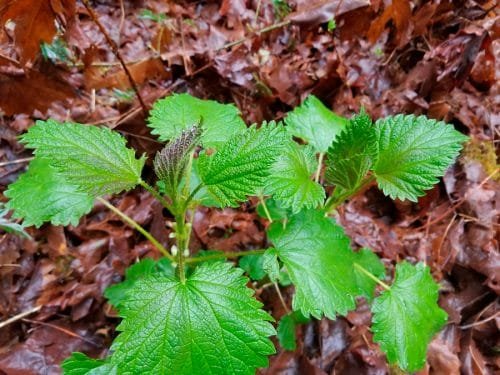 Wild nettles are easy to spot. Photo: Adam Deleo
Wild nettles are easy to spot. Photo: Adam Deleo
For those willing to seek it out, the forests and beaches of the Key Peninsula can provide an abundance of food. While foraging may be seeing a resurgence in popularity and wild foods deck the menus of many local-focused restaurants, the tradition of searching for wild food sources is nothing new. Throughout the Pacific Northwest, indigenous populations have depended on the bounty of the natural environment for centuries.
“Wild foods are a bit of an acquired taste, but it’s really rewarding,” says Adam Deleo, founder of the Key Peninsula based Adam’s Mushrooms, which sells foraged and farmed mushrooms as well as other local, wild Pacific Northwest foods. “You get some fresh air, you get some exercise, and you get some food.”
Foraging advocates often mention the health benefits of wild food. “It’s fresh, it’s free and its healthy,” says Brook Hurst Stephens, who lives in Longbranch at Historic Faraway. “(There are) no preservatives or artificial flavorings in nature.”
Foraging is a seasonal activity, and in the springtime, some of the most common wild foods to forage are nettles. Nettles are nutrient-rich and easy to find, and while their stinging aspect causes most people to veer away from them, they’re an abundant food source. “They like to grow in margin areas, like the edge of forests,” says Deleo. Nettles are best harvested when they are young, and Deleo encourages foragers to wear gloves to avoid being stung and to pick the top two or three sets of leaves. Nettles can continue to be harvested even as they grow a little older. “I stop harvesting them when I see them going to seed,” says Deleo.
Boiling, blanching or drying causes the nettles to lose their sting. There are many culinary uses for nettles, and Deleo recommends thinking of them as similar to spinach. They can be sauteed with a little chopped garlic, olive oil and lemon juice, added to pasta or on top of a pizza, or dried and used for nettle tea. One of Deleo’s favorite meals is enchiladas stuffed with blanched nettles.
In early spring, fiddleheads, lady ferns curled tightly together before they start to unfurl, also start to pop up. “They like really wet soils,” says Deleo, so look for them in wet areas and creek bottoms.
Fiddleheads have a slightly grassy taste. Before cooking, they need to be properly cleaned––easy to do by placing them in a bowl of water and then rubbing the fuzzy bits off. They shouldn’t be consumed raw, so boil them in salt water first for about 10 minutes before using them. “You can have them in your pasta or as a side, or just put them on top of stuff,” says Deleo. “Serve them with some hollandaise.”
Hurst Stephens also suggests pickling them. In fact, she once won the Grand Champion Best of Show in the preserved foods category at the Mason County Fair for her pickled fiddleheads.
Other spring edibles include miner’s lettuce and dandelion greens, and as spring turns to summer, other wild foods will flourish, like huckleberries, blackberries and salmonberries. Whatever wild foods you are foraging, it’s important to know what you are looking for. Deleo recommends the Facebook group “PNW Foraging and Wild Edibles” as a good resource, both for learning about wild foods and for posting pictures if you’re not sure about what you’re looking at.
Secondly, know where you are foraging. Be respectful of private land, and remember that commercial foraging is not allowed on state park land. There are limits for how much you can forage for personal use; check with a ranger if you are unsure.
For more foraging information, check out the book “Pacific Northwest Foraging” by Douglas Deur, which is a helpful guide to local plants. “Pacific Feast: A Cook’s Guide to West Coast Foraging and Cuisine” by Jennifer Hahn is great if you are looking for ideas on what to do with all that wild food. Whatever you do, remember that foraging is an excellent excuse to get outside and enjoy all that the local forests and shorelines have to offer. “It’s a nice way to be outside and it’s really practical,” says Deleo. “You can get a meal at the end of the day.”
UNDERWRITTEN BY THE FUND FOR NONPROFIT NEWS (NEWSMATCH) AT THE MIAMI FOUNDATION, THE ANGEL GUILD, ADVERTISERS, DONORS AND PEOPLE WHO SUPPORT INDEPENDENT, NONPROFIT LOCAL NEWS